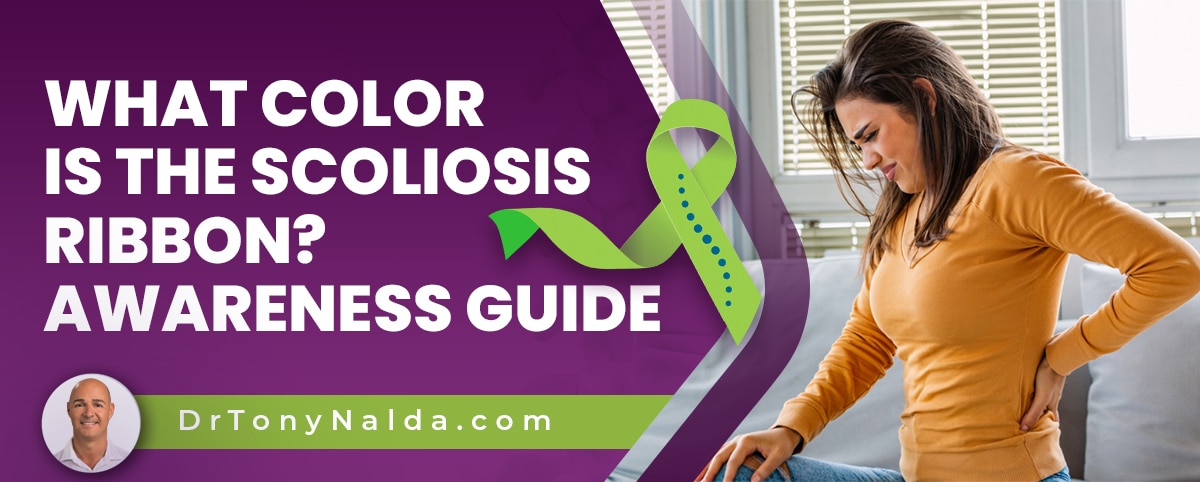What Color Is the Scoliosis Ribbon? Awareness Guide

It's important to be aware of the prevalence of scoliosis and its early signs; it can lead to early diagnosis and intervention. Spreading awareness can help individuals recognize the condition's early signs; there are a number of benefits associated with starting treatment early in a condition's progressive line.
The scoliosis awareness ribbon is green, and June is scoliosis awareness month. Wearing the ribbon during June shows awareness of the condition's prevalence. Current estimates have close to seven million people living with scoliosis in the United States alone.
As a progressive condition, the nature of scoliosis is to become more severe over time, and this is something patients need to fully understand.
Table of Contents
Scoliosis is a Progressive Condition
A green ribbon indicates scoliosis awareness, and as a progressive condition, the nature of scoliosis is to get worse, hence the importance of proactive treatment.
Progressive conditions benefit from being diagnosed early because this means treatment can be started early.
The benefits of early detection are only available to those who are committing to a proactive conservative treatment response.
Proactive treatment is started immediately following a diagnosis because this is when conditions are at their mildest and likely to be the most responsive; scoliosis can be highly treatable.
As scoliosis causes an unnatural sideways-bending spinal curve that also rotates to develop, as it's progressive, the size of the curve will increase as with the condition's effects.
As the unnatural spinal curve gets larger, the condition is introducing more uneven forces to the body, and this can disrupt posture and movement.
Being aware of scoliosis while mild means treatment can be started while conditions are mild and more responsive; smaller curves are easier to correct than larger curves.
Why Is Scoliosis Awareness Important?
 With current estimates at close to seven million people currently living with scoliosis in the United States alone, and with scoliosis being the leading spinal condition among school-aged children, awareness is needed.
With current estimates at close to seven million people currently living with scoliosis in the United States alone, and with scoliosis being the leading spinal condition among school-aged children, awareness is needed.
In fact, there was a time when mandatory scoliosis screening was conducted in schools across America by school nurses, but that's no longer automatic, making it more important than ever before for parents and/or caregivers to recognize the condition's early signs.
So what are the early signs of scoliosis? In many cases, the earliest signs of scoliosis involve uneven shoulders and hips.
Additional changes to look for can include uneven shoulder blades, the development of a rib cage arch, arms and legs that hang at different lengths, and these types of changes can make clothing suddenly seem ill-fitting with necklines pulling to one side and shirt sleeves and pant legs not hanging evenly.
Other changes to watch for involve movement: changes to gait, balance, and coordination are also common.
Being aware of how the condition affects the body means you can recognize its early signs and the need for further assessment.
So if you have noticed a postural asymmetry in your child, what's the next step?
Scoliosis Screening Examination
If a single postural asymmetry is noticed, this doesn't guarantee a scoliosis diagnosis, but it does warrant further testing.
If risk factors such as gender, age, and a family history are present, regular screening is a good idea.
A screening examination would include taking the patient's medical and family history and conducting a physical examination that looks for condition indicators.
An adams forward bend test is the gold standard in scoliosis screening exams and involves the patient standing in front of me and bending forward at this hips as if touching the toes; in this position, the spine and trunk are highly visible, so I'm looking for signs that the spine is unnatural bend and/or twisted and any related trunk asymmetries.
When combined with the use of a ScolioMeter, I can also determine the angle of trunk rotation (ATR).
So if a physical examination and Adams forward bend test finds indicators for scoliosis, further testing is warranted in the form of a scoliosis X-ray.
A scoliosis X-ray is needed to reach an official diagnosis of scoliosis: to confirm the size of the unnatural spinal curve is at least 10 degrees and that there is rotation present.
Once a diagnosis is reached, conditions are comprehensively assessed so they can be classified accordingly.
Diagnosing and Classifying Scoliosis
There are many spinal conditions that cause a loss of healthy spinal curves, but scoliosis has some characteristics that set it apart from the rest.
Part of the diagnostic process involves assessment so conditions can be further classified based on key patient/condition variables.
Conditions are classified based on patient age, condition type, condition severity, and curvature location.
Patient age is important because as a progressive condition triggered by growth, the more growth a patient has yet to go through means the more potential progression; it's also an important factor because scoliosis becomes a compressive condition once skeletal maturity has been reached.
Compression is uneven pressure and is the main cause of condition-related pain which can involve the muscles, the back, and most often, pain that radiates into the extremities due to nerve compression, so pain management has to be a focus of adult scoliosis, but isn't as common in childhood scoliosis.
Condition type is determined by causation and is important because to treat effectively, its underlying cause has to be addressed, so type also shapes the course of treatment.
Condition severity ranges from mild scoliosis to moderate, severe, and very severe cases; the goal of treatment is to keep mild cases mild and prevent further progression.
Curvature location is important because it tells me where to concentrate my treatment efforts and also indicates the types of symptoms a patient is likely to experience; in most cases, the area of the body located the closest to an affected spinal section is going to feel most of its direct effects.
The highly-variable nature of scoliosis necessitates the complete customization of effective treatment plans, so treatment plans are shaped around key classification points.
June Is Scoliosis Awareness Month
 The goal of scoliosis awareness month is to increase awareness so the condition's early signs can be recognized; this can lead to early detection and early intervention.
The goal of scoliosis awareness month is to increase awareness so the condition's early signs can be recognized; this can lead to early detection and early intervention.
There are never treatment guarantees, but early detection and intervention is directly related to treatment success.
With most progressive conditions, the sooner treatment is started, the better because waiting can mean allowing conditions to progress unimpeded, and progression makes conditions more complex to treat.
In most cases, it's far more effective to proactively work towards preventing progression than it is to attempt to work towards reversing effects once they're established.
Spreading the benefits of early detection can mean more people understand the progressive nature of scoliosis and the benefits of watching for signs and responding immediately.
National Scoliosis Awareness Month highlights the need for awareness regarding the prevalence of scoliosis.
Scoliosis awareness also means understanding the different types of treatment options available, and how best to address the condition.
The two main treatment responses are surgery or a conservative non-surgical treatment response.
Proactive Scoliosis Treatment
As mentioned, the benefits of early detection are only available to those who are treating their condition with a proactive conservative treatment plan, and this means starting treatment immediately following a diagnosis.
Conditions are more responsive the milder they are, and as progression makes conditions more complex to treat, there are a number of benefits associated with starting treatment early in a condition's progressive line.
While traditional scoliosis treatment doesn't have a strategy for addressing scoliosis while mild, conservative treatment integrate chiropractic care, physical therapy, scoliosis exercises, corrective bracing, and rehabilitation so conditions are impacted on every level, and when scoliosis is still mild is the best time to start treatment.
The goal of conservative non-surgical treatment is to stop progression and increasing condition effects, rebalance the spine, and prevent the need for invasive surgical treatment in the future.
Conclusion
Every June, green ribbons can be worn to represent scoliosis awareness and to acknowledge the challenges patients face.
One of the most significant challenges associated with scoliosis is its progressive nature, so if spreading awareness leads to even a single patient being diagnosed early, this is worth the effort.
So if you see a green ribbon being worn during the month of June, it's likely these people are living with scoliosis and/or are caring for someone with the condition.
A green ribbon symbolizes awareness and hope because the reality is that many cases of scoliosis are highly treatable, particularly with early detection and intervention.
Here at the Scoliosis Reduction Center®, patients benefit from a multi-faceted conservative treatment approach that combines the power of chiropractic care, physical therapy, corrective bracing, and rehabilitation.
So this June, take some time to think about the challenge of living with scoliosis: a progressive condition that causes the spine to bend and twist unnaturally.
While there are never treatment guarantees, the earlier treatment is started, the better.
Dr. Tony Nalda
DOCTOR OF CHIROPRACTIC
After receiving an undergraduate degree in psychology and his Doctorate of Chiropractic from Life University, Dr. Nalda settled in Celebration, Florida and proceeded to build one of Central Florida’s most successful chiropractic clinics.
His experience with patients suffering from scoliosis, and the confusion and frustration they faced, led him to seek a specialty in scoliosis care. In 2006 he completed his Intensive Care Certification from CLEAR Institute, a leading scoliosis educational and certification center.
About Dr. Tony Nalda
 Ready to explore scoliosis treatment? Contact Us Now
Ready to explore scoliosis treatment? Contact Us Now





